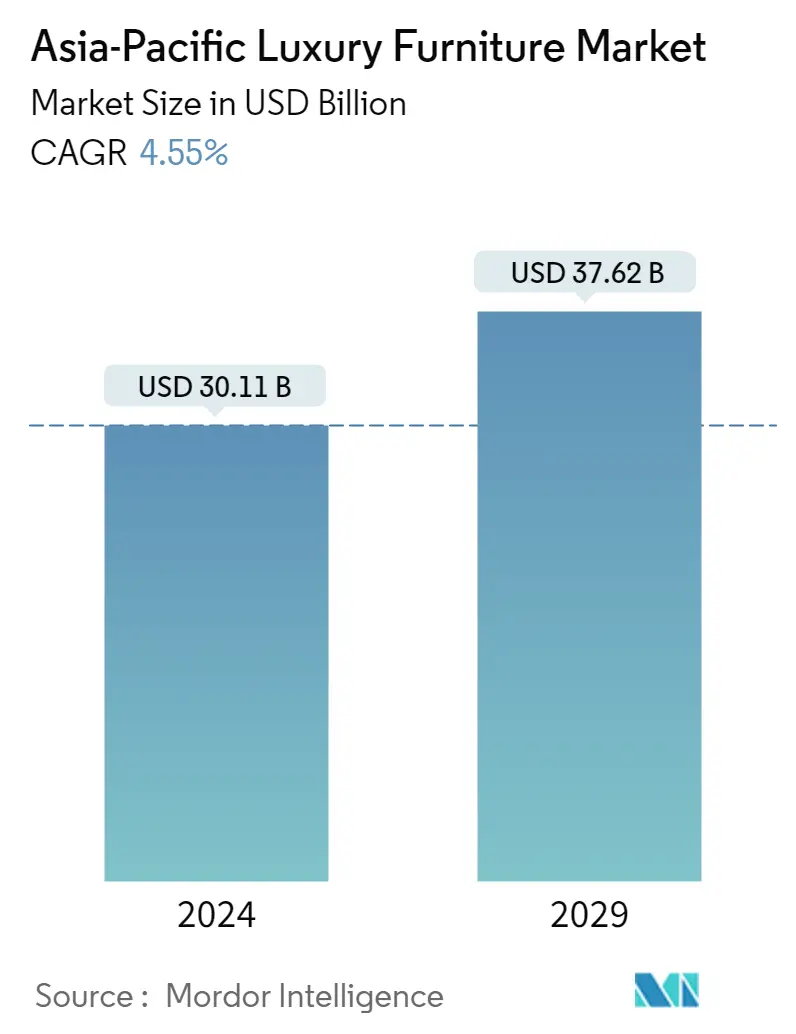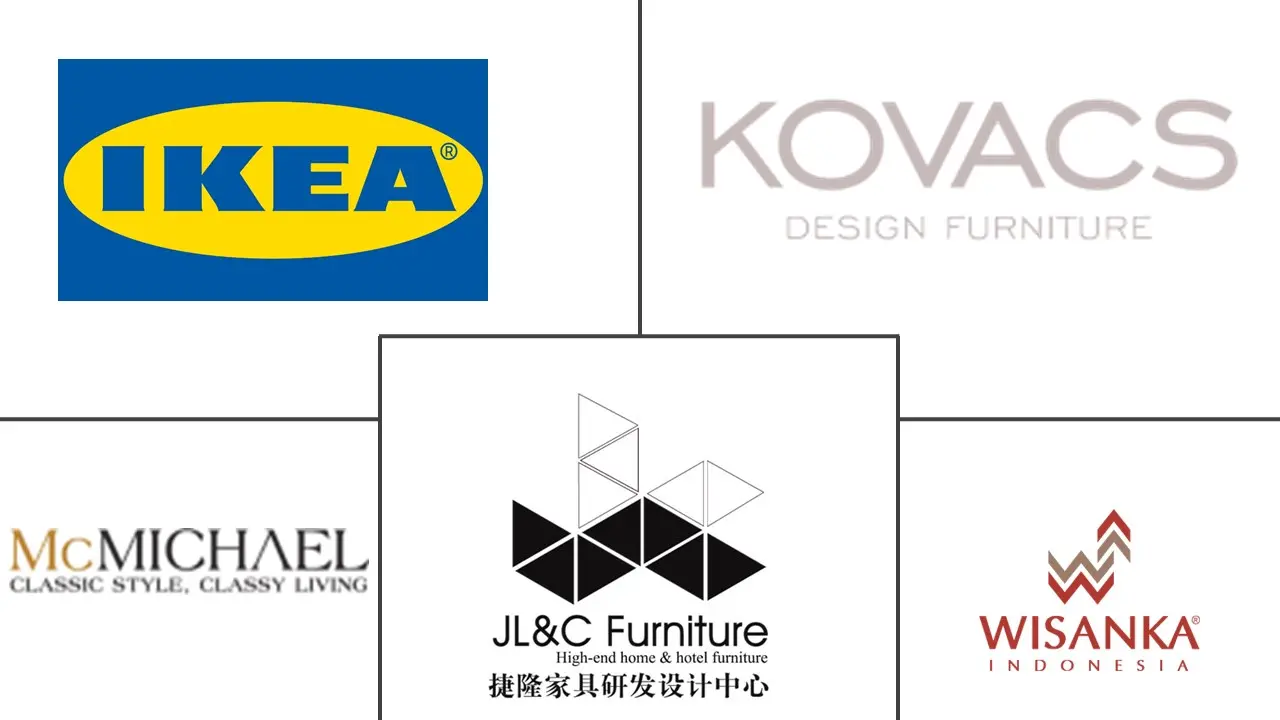Market Size of Asia-Pacific Luxury Furniture Industry

| Study Period | 2020 - 2029 |
| Base Year For Estimation | 2023 |
| Market Size (2024) | USD 30.11 Billion |
| Market Size (2029) | USD 37.62 Billion |
| CAGR (2024 - 2029) | 4.55 % |
| Market Concentration | Medium |
Major Players
*Disclaimer: Major Players sorted in no particular order |
APAC Luxury Furniture Market Analysis
The Asia-Pacific Luxury Furniture Market size is estimated at USD 30.11 billion in 2024, and is expected to reach USD 37.62 billion by 2029, growing at a CAGR of 4.55% during the forecast period (2024-2029).
Furniture is required to decorate the interiors and exteriors of homes, hotels, and offices. The quality of material used, aesthetic value, comparative price, and sophistication in design are some of the key factors that differentiate luxury furniture from non-luxury furniture. Expert and inventive craftsmen use high-quality materials like metal, wood, glass, plastic, and leather to create luxury furniture.These luxury furnishings are designed with zero margin of error, thereby prolonging their durability.
Because of the COVID-19 outbreak, supply chains were messed up, there was a shortage of materials, and contracts were canceled to keep costs down.The lack of labor is also hampering the overall expansion of the luxury furniture market, particularly in countries including India, China, and Japan. The outbreak of the COVID-19 pandemic acted as a massive restraint on the luxury furniture manufacturing market in the Asia-Pacific region in 2020. This may slow down the industry's growth during the forecast timeframe. Sales dropped by almost 70% as consumers had little opportunity to explore luxury furniture products. Major luxury furniture production happens in Italy, and all the Italian factories, including small and family-based fabriqueries, have temporarily shut down, which resulted in a decline in sales in the market.
Asia-Pacific consumers have had more money to spend because the economies of different countries in the region have been slowly but steadily getting better.This high disposable income and inclination of consumers toward luxury furniture fuel market growth. The growing popularity of luxury indoor furniture, such as bedrooms, bathrooms, kitchens, and other types of furniture, is likely to augment the sales of luxury furniture in the domestic segment.
The market is witnessing an increase in demand for luxury furniture made from premium woods such as mahogany and alder. Also, the real estate and construction industries are expected to grow substantially in this region. In addition to this, urbanization and the improving lifestyles of individuals are some of the important factors responsible for the prominent growth of the Asia-Pacific luxury furniture market. Moreover, the rise in the need to manufacture eco-friendly luxury furniture is expected to offer lucrative opportunities for market expansion in the forthcoming years. However, factors such as the increasing cost of raw materials, specifically wood and leather, would limit the Asia-Pacific luxury furniture market's growth.
APAC Luxury Furniture Industry Segmentation
Luxury furniture helps you live in style and comfort, with pieces that are elegant, luxurious, and indulgent.They are manufactured with the best available material and craftsmanship and enhanced with beautiful elements.
The Asia-Pacific Luxury Furniture Market Is Segmented By Product Type (Lighting, Tables, Chairs, Sofas, Accessories, Bedrooms, Cabinets, And Other Product Types), End User (Residential And Commercial), Distribution Channel (Home Centers, Flagship Stores, Specialty Stores, Online, And Other Distribution Channels), And Geography (Japan, India, China, Singapore, Malaysia, And Other Asia-Pacific Countries). The Report Offers Market Size And Forecasts For The Asia-Pacific Luxury Furniture Market In Volume (Number Of Products) And Value (USD) For All The Above Segments.
| Product Type | |
| Lighting | |
| Tables | |
| Chairs and Sofas | |
| Accessories | |
| Bedroom | |
| Cabinets | |
| Other Product Types |
| End-User | |
| Residential | |
| Commercial |
| Distribution Channel | |
| Home Centers | |
| Flagship Stores | |
| Specialty Stores | |
| Online | |
| Other Distribution Channels |
| Geography | |
| Japan | |
| India | |
| China | |
| Singapore | |
| Malaysia | |
| Other Asia-Pacific Countries |
Asia-Pacific Luxury Furniture Market Size Summary
The Asia-Pacific luxury furniture market is poised for significant growth, driven by increasing disposable incomes and a growing preference for high-end furnishings. This market is characterized by the use of premium materials such as wood, metal, glass, and leather, crafted by skilled artisans to ensure durability and aesthetic appeal. The region's economic recovery post-COVID-19 has bolstered consumer spending, particularly in countries like China and India, where urbanization and improved lifestyles are fueling demand. The rise of online retailing has further enhanced market accessibility, with major players like IKEA and Amazon expanding their digital presence to cater to the evolving consumer preferences for luxury furniture.
Despite challenges such as rising raw material costs and labor shortages, the market is witnessing a surge in demand for eco-friendly and multifunctional furniture. The real estate and construction sectors' growth, coupled with the increasing popularity of luxury indoor furniture, is expected to drive market expansion. Key international players, along with strategic partnerships and technological advancements, are enhancing their market presence. The focus on digitalization and online commerce is creating new opportunities for sales growth, particularly in China, where high-end furniture is becoming a staple in urban residences.
Asia-Pacific Luxury Furniture Market Size - Table of Contents
-
1. MARKET INSIGHTS AND DYNAMICS
-
1.1 Market Overview
-
1.2 Market Drivers
-
1.3 Market Restraints
-
1.4 Value Chain/Supply Chain Analysis
-
1.5 Porter's Five Forces Analysis
-
1.5.1 Bargaining Power of Buyers/Consumers
-
1.5.2 Bargaining Power of Suppliers
-
1.5.3 Threat of New Entrants
-
1.5.4 Threat of Substitute Products
-
1.5.5 Intensity of Competitive Rivalry
-
-
1.6 Impact of COVID-19 on the Market
-
-
2. MARKET SEGMENTATION
-
2.1 Product Type
-
2.1.1 Lighting
-
2.1.2 Tables
-
2.1.3 Chairs and Sofas
-
2.1.4 Accessories
-
2.1.5 Bedroom
-
2.1.6 Cabinets
-
2.1.7 Other Product Types
-
-
2.2 End-User
-
2.2.1 Residential
-
2.2.2 Commercial
-
-
2.3 Distribution Channel
-
2.3.1 Home Centers
-
2.3.2 Flagship Stores
-
2.3.3 Specialty Stores
-
2.3.4 Online
-
2.3.5 Other Distribution Channels
-
-
2.4 Geography
-
2.4.1 Japan
-
2.4.2 India
-
2.4.3 China
-
2.4.4 Singapore
-
2.4.5 Malaysia
-
2.4.6 Other Asia-Pacific Countries
-
-
Asia-Pacific Luxury Furniture Market Size FAQs
How big is the Asia-Pacific Luxury Furniture Market?
The Asia-Pacific Luxury Furniture Market size is expected to reach USD 30.11 billion in 2024 and grow at a CAGR of 4.55% to reach USD 37.62 billion by 2029.
What is the current Asia-Pacific Luxury Furniture Market size?
In 2024, the Asia-Pacific Luxury Furniture Market size is expected to reach USD 30.11 billion.

